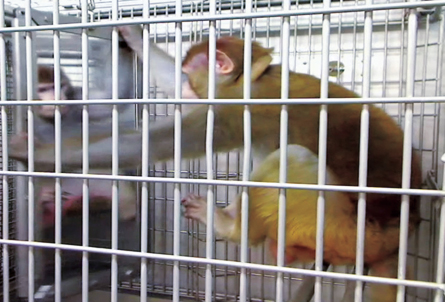
Rhesus monkeys typically don’t check themselves out in a mirror — unless they’re wearing funky acrylic forehead blocks attached to hair-thin electrodes implanted in their brains.
Given that fashion-forward apparel, these monkeys avidly use mirrors to examine and groom their heads and to inspect hard-to-see body areas, say neuroscientist Luis Populin of the University of Wisconsin–Madison and his colleagues.
Animals with head implants sometimes turned themselves upside down or adjusted mirrors to get a better view of out-of-the-way body parts, the scientists report in a paper published online September 29 in PLoS ONE.
“Rhesus monkeys recognize themselves in the mirror and have some form of self-awareness,” Populin holds.
As in previous studies, monkeys with colored marks on their faces failed to inspect the marks when provided with mirrors and sometimes made aggressive moves as if the marked reflection were another monkey. Researchers generally regard such behavior as showing a lack of self-awareness. Unlike facial marks, though, implanted head devices presented monkeys with a bodily change striking enough to trigger self-inspection with a mirror, Populin proposes.
“It is hard to say what is going on, as the head implant is not only seen but felt by monkeys,” remarks psychologist Frans de Waal of Emory University in Atlanta. This new evidence supports the idea that monkeys recognize their own reflections as special and don’t misidentify the images as other monkeys, he says, even if it doesn’t establish that the animals have a concept of self (SN: 7/23/05, p. 53).
Populin’s experiment may indicate that monkeys familiar with mirrors use reflections to explore objects that they’ve already seen and felt directly, remarks psychologist Gordon Gallup, Jr. of the State University of New York at Albany. No conclusions about self-awareness can be drawn until researchers study monkeys with head implants but no mirror experience, Gallup says.
The new study was inspired by observations in Populin’s lab of two monkeys using mirrors to inspect head implants given in preparation for brain studies. As part of an enriched laboratory environment, the animals had long had access to mirrors.
In one experiment, five adult male rhesus monkeys were videotaped during five one-hour periods in cages that held small mirrors attached from the outside. Black plastic covered the mirrors during another five one-hour sessions.
Monkeys frequently used the mirror to touch and groom themselves around the implant and to inspect their genitals, the researchers say. Virtually no attempts at self-inspection occurred in covered-mirror trials.
In a second experiment, the same monkeys could see themselves completely in a large, swiveling mirror inside the cage. Black plastic covered this mirror during some trials.
After initial hesitation, monkeys inspected and groomed their heads in this mirror. They also spent time swiveling the mirror and doing contortions for a reflected view of their genitals.
Sneak peeks from Science News on Vimeo.
A rhesus monkey in a University of Wisconsin-Madison lab contorts its body in front of a mirror to inspect itself in a reflection. Researchers think such behavior may signal a form of self-awareness in these animals.
Credit: Courtesy L. Populin





